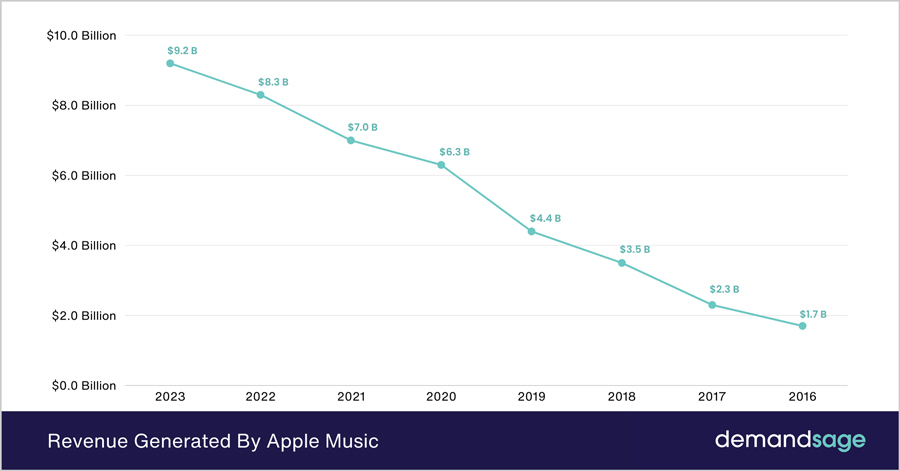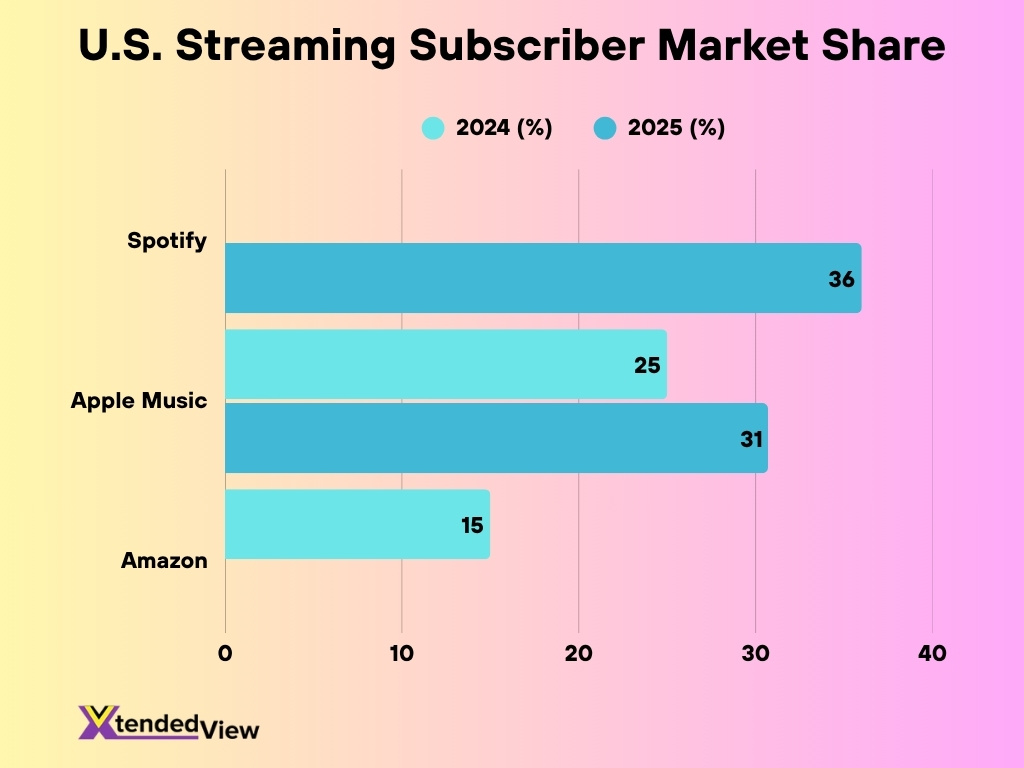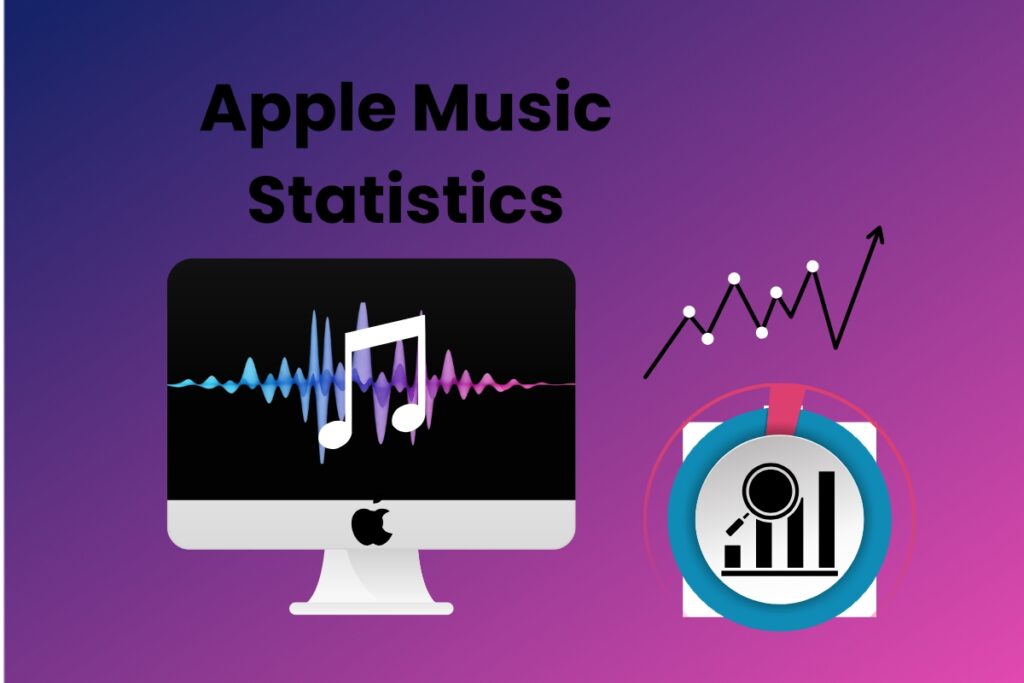Introduction
Apple Music continues to be a major player in the music streaming economy. With millions of paying users globally and billions in revenue, it shapes how artists monetize and how users discover music. In commerce, labels and independent artists use Apple Music data to guide marketing and release strategies. In tech, device makers tie their audio hardware to Apple Music as part of ecosystem lock-in. Read on to explore the detailed numbers that define Apple Music’s place.
Editor’s Choice
These are seven standout statistics that capture Apple Music’s scale, growth, and competitive position in 2025:
- Over 93 million paying subscribers globally, marking a steady uptrend from prior years.
- $9.2 billion in estimated revenue in 2023, with double-digit year-over-year growth.
- Approximately 30.7 % U.S. subscriber market share in 2024, placing Apple Music second only to Spotify.
- Service availability in 167 countries, giving it a broad global reach.
- Catalog size exceeding 100 million songs and 30,000 playlists.
- Female users make up 56 % of its user base, while male users are 44 %.
- Projected growth to 112 million paying subscribers in 2024, with upward momentum into 2025.
Recent Developments
- In 2025, Apple struck a partnership with TuneIn, making its six live radio stations available via TuneIn’s distribution, expanding reach beyond Apple devices.
- The move integrates Apple’s radio content with TuneIn’s ~75 million listeners globally.
- Reports suggest Apple’s U.S. digital music subscriber share slipped to 25 % by the end of 2024, down from roughly 30 % in 2020.
- Some sources argue that adjusting for new data pushes Apple’s U.S. share closer to 32 % in mid-2025.
- The global music streaming market reached $46.7 billion in early 2025, rising from $34.5 billion in 2022.
- Subscription streaming revenues now account for over 50 % of global recorded music revenues.
- Apple’s inclusion of Apple Music revenue in its overall Services segment strengthens its recurring revenue model within Apple’s ecosystem.
- Industry watchers caution that growth is flattening in mature markets and differentiation, e.g., spatial audio, AI, will matter more going forward.
Global Subscriber Base & Growth
- As of mid-2024, Apple Music had an estimated 94 million paying subscribers, up from 93 million in 2023.
- In 2023, Apple added ~5 million net new subscribers over 2022’s ~88 million base, implying ~5.7 % growth.
- Some forecasts expect the total to approach 112 million by the end of 2024, representing a ~10.9 % rise.
- Other estimates project as many as 124 million subscribers by 2025, implying sustained double-digit growth.
- Apple’s growth is notable given it does not offer a permanent free ad-supported tier, unlike many competitors.
- The service is available in 167 countries, supporting scale in many emerging and developed markets.
- In mature markets, growth has slowed, pushing Apple to lean more on new features like spatial audio and joined platforms, e.g., radio.
- The broader streaming market had 667 million global subscribers in 2023, giving Apple a slice of a large audience base.

Apple Music Revenue Figures
- In 2023, Apple Music generated an estimated $9.2 billion in revenue.
- That figure represents roughly 10.84 % growth over 2022’s $8.3 billion.
- Prior annual revenues were: $7.0 billion in 2021, $6.3 billion in 2020, and $4.4 billion in 2019.
- Apple Music contributes about 6.4 % to Apple’s total Services revenue segment.
- The global music streaming sector posted $16 billion in revenue in 2023 and $17.7 billion in 2024.
- From 2014 onwards, music streaming revenue has grown annually at an average of 43.9 %, driven by increasing subscriptions globally.
- In 2025’s broader landscape, streaming is expected to remain the primary source of recorded music income, exceeding physical formats and downloads.
- Apple Music’s per-stream payout is often quoted at around $0.01, among the higher rates in the industry.

Market Share of Apple Music vs Competitors
- In the U.S., Apple Music holds approximately 30.7 % of the music streaming subscriber market, second to Spotify’s 36 % share.
- Some 2025 reports argue Apple’s U.S. share has drifted closer to 32 %, narrowing the spread with Spotify.
- On a global scale, Spotify commands ~37 % of market share among paid streaming platforms as of 2025.
- Apple Music is often cited as preferred by about 1 in 8 global streaming users, roughly 12.5 % share worldwide.
- In U.S. monthly usage metrics, 16 % of Americans, age 12+, report using Apple Music monthly, trailing Spotify’s 35 % and ahead of Amazon at 15 %.
- In 2024, Apple’s U.S. digital music subscriber share was reported to have dropped to 25 %, down from prior levels.
- Apple’s partnership with TuneIn aims to regain or stabilize its share by expanding access to the platform’s radio assets.
- The competitive landscape is tightening, and YouTube Music, Amazon Music, and other services are gaining on differentiators such as hybrid content, pricing, and device integration.

Apple Music Users by Country & Region
- The United States accounts for ~32.6 million Apple Music subscribers, making it the largest regional user base.
- North America leads in premium adoption, with about 59 % of users there on paid plans.
- In Europe, a larger share remains on free or trial tiers; roughly 64 % of users in that region are non-premium.
- The Asia-Pacific region has 38 % premium users versus 62 % non-premium, indicating lower monetization.
- Latin America shows a split: 44 % of users on premium plans, 56 % not.
- Middle East & Africa regions hold a 43 % / 57 % split between premium and free users.
- Apple Music is currently available in 167 countries, spanning all continents except some restricted zones.
- In many emerging markets, bundled deals with telecoms are driving growth, e.g., India deals with Airtel.
Apple Music User Demographics
- 56 % of all Apple Music users are female, 44 % are male.
- The largest age bracket is 25–44 years, which together make up ~45 % of users.
- Specifically, 23 % fall in 25–34 and 22 % in 35–44.
- Users 18–24 comprise about 17 % of the base.
- Users aged 45–54 make up around 15 %.
- Those 55+ also represent 23 %, showing a mature audience segment.
- Apple Music for Artists enables breakdowns by gender, age, and location for creators to tailor marketing.
- In many Western markets, the share of female users is even higher, reinforcing trends toward gender skew.
Apple Music Users by Age Group
- Age 25–34 and 55+ both hold 23 % of the share, tied for the largest groups.
- Age 35–44 is next with 22 %.
- Age 18–24 holds 17 %.
- Age 45–54 accounts for 15 %.
- In the 25–34 bracket, users also tend to consume more hours per day compared to older groups.
- Among users 55+, many engage with nostalgic playlists, classical formats, and curated radio.
- The distribution suggests Apple Music’s growth depends heavily on attracting younger cohorts while retaining older users.
Apple Music Free vs Premium Users (Regional Breakdown)
- North America, 59 % premium users / 41 % non-premium.
- Europe, 36 % premium / 64 % free or trial.
- Asia-Pacific, 38 % premium / 62 % non-premium.
- Latin America, 44 % premium / 56 % non-premium.
- Middle East & Africa, 43 % premium / 57 % non-premium.
- The trend underscores monetization challenges in many non-Western markets.
- In some markets, the “free” bucket includes trial periods, promotions, or bundled access via telecoms.
- The share of premium users globally is growing but unevenly across regions, with mature markets outperforming.
- Emerging markets may require localized pricing or offerings to convert free users to paid.
Apple Music Library Size and Content
- Apple Music’s catalog exceeds 100 million songs.
- It hosts 30,000+ curated playlists by genre, mood, or editorial themes.
- The platform offers dozens of live radio stations, Apple Music 1, Hits, Country, etc.
- Apple Music also includes music videos, exclusive performances, and documentaries.
- Spatial audio and Dolby Atmos tracks number in the hundreds of thousands.
- Live shows, artist interviews, and original content add a multimedia dimension beyond audio.
- The library is dynamic; Apple adds new releases daily, including exclusives in many regions.
- This breadth helps Apple compete not just on quantity, but on diversity of offerings.
Most Streamed Artists on Apple Music
- Taylor Swift remains the most-streamed artist, with total streams exceeding 72.9 million.
- Ed Sheeran ranks second with ~65.2 million streams.
- Billie Eilish occupies third with ~52.3 million streams.
- Drake follows with ~50.7 million streams.
- The Weeknd sits in the top five with ~38.9 million streams.
- Post Malone is also in top rank with ~38.7 million streams.
- Bad Bunny crosses ~36.5 million streams.
- Ariana Grande clocks ~35.6 million streams.
Most Streamed Songs on Apple Music
- In 2025, Apple released a list of the top 500 most-streamed songs since its launch in 2015.
- At the top of that list is “Shape of You” by Ed Sheeran, making it Apple Music’s most-streamed song ever.
- “Blinding Lights” by The Weeknd ranks second, with “God’s Plan” by Drake third.
- Other frequent entries include “Sunflower,” “Rockstar,” “One Dance,” “Perfect,” and “Bad Guy.”
- On daily charts, the #1 most-streamed song in mid-2025 was “What I Want” by Morgan Wallen & Tate McRae.
- The Top 10 songs list for 2025 includes hits such as Anti-Hero, Bones, and Hold Me Closer.
- The heavy skew toward longevity and recurrent hits, vs just new releases, underlines how songs with sustained appeal dominate streaming metrics.
Artist Earnings and Royalties on Apple Music
- Apple Music’s average per-stream royalty is often cited at about $0.01 for paid individual plan streams.
- In 2024, Apple began awarding up to 10 % higher royalties for songs available in Spatial Audio.
- Over 80 % of songs on Apple’s Global Daily Top 100 are available in Spatial Audio format.
- Apple reports that more than 90 % of its listeners have engaged with Spatial Audio content.
- Plays of Spatial Audio tracks have more than tripled over the past two years in Apple’s reporting.
- Global streaming rights revenue in 2025 is projected to exceed $28.4 billion, with about 68 % of that going to record labels and rights holders.
- Artists argue Apple’s royalty rates are among the most favorable compared to many streaming platforms.
- However, the per-stream rates vary by country, licensing deals, subscription tier, and currency adjustments.
Apple Music for Artists: Tools and Analytics
- The Apple Music for Artists dashboard provides metrics on streams, audience geography, listener demographics, and playlist placements.
- Artists can filter by country, age group, gender, and device type to see listener behavior.
- It also shows real-time data for song performance, aiding release and promotional timing strategies.
- The tool tracks how many times a track enters charts or playlists, offering visibility into momentum.
- Artists are alerted when playlists add their tracks, which can help with fan outreach and marketing.
- Analytics include trends over time, allowing comparisons between release periods.
- It supports attribution for plays driven by radio, social media, or editorial placements.
- Over time, Apple has expanded the tool’s features, such as reporting on Spatial Audio vs standard streams.
Apple Music App Engagement and Listening Habits
- Users who enable Spatial Audio reportedly spend 19 % more time per week using Apple Music.
- Lossless Audio adoption jumped from 42 % in 2024 to over 57 % in 2025 among users.
- Spatial Audio adoption rose to 38 % in 2025.
- Engagement is higher in genres like classical, jazz, ambient, and electronic, where immersive formats deliver more value.
- Users streaming in Spatial or Lossless formats tend to listen to albums more than shuffling singles.
- Peak listening hours are evenings, 6 pm to 10 pm local time, with weekends showing 20–25 % higher hours overall.
- On average, users listen to 1.5 to 2 hours daily on the app.
- Retention is higher among users who regularly explore curated playlists or radio stations.
Lossless and Spatial Audio Adoption Rates
- More than 57 % of Apple Music users have enabled Lossless Audio in 2025.
- Spatial Audio usage has grown to 38 % of users.
- Apple’s decision to boost royalties for Spatial tracks is an incentive for labels to mix for that format.
- The number of tracks available in Spatial Audio has expanded by nearly 5,000 % since its launch.
- In the past year alone, the catalog of Spatial Audio–enabled songs has more than doubled.
- Hi-Res Lossless streaming is strongest in markets like Japan, Germany, and the U.S., particularly in classical and jazz.
- Usage of high-fidelity formats is concentrated among premium plan users and audiophiles.
- The more immersive audio formats are becoming differentiators in global markets where streaming has matured.
Trends in Apple Music Playlists and Curated Content
- Apple continues to curate tens of thousands of playlists, segmented by mood, genre, region, season, and activity.
- Editorial playlists remain a major driver of discovery and streaming volume for new releases.
- The “Viral” playlists, in partnership with Shazam, now highlight songs rising in real-world discovery.
- Apple’s playlists increasingly integrate Spatial Audio tracks to promote the immersive listening upgrade.
- Seasonal playlists, e.g., holiday, summer, workout, see spikes, often correlating with promotional pushes.
- Apple also curates Replay playlists, end-of-year personal summaries, which drive user engagement and sharing.
- Exclusive or limited releases tied to playlists, e.g., bonus tracks in a curated list, are growing.
- Regional and local language playlists help Apple deepen adoption in non-English markets.
Apple Music’s Role in Podcasting and Original Content
- Apple Music competes with Apple Podcasts by integrating original audio content, interviews, and documentary-style features.
- Though not as podcast-centric as Spotify, Apple is slowly building a hybrid content model combining music and spoken word.
- Some editorial playlists embed spoken interludes or artist commentary tracks exclusive to Apple.
- Exclusive releases, e.g., artists’ behind-the-scenes, mini audio series, sometimes appear only in Apple’s ecosystem.
- Apple has not yet released full metrics on podcast listening within Apple Music, making comparisons difficult.
- The blend of music and original audio positions Apple Music to capture listener hours beyond just music.
- For artists and creators, this opens a new channel for storytelling and fan connection.
- Over time, Apple may pursue more podcast acquisitions or original series to expand its content scope.
Frequently Asked Questions (FAQs)
Over 93 million paying subscribers as of mid‑2023, with estimates reaching 94 million+ in 2025.
Approximately $9.2 billion in revenue for 2023.
Roughly 30.7 % of U.S. streaming subscribers.
Around $0.01 per stream (for paid individual plan streams).
Available in 167 countries, with a catalog exceeding 100 million songs.
Conclusion
Apple Music is more than a streaming service; it is a layered ecosystem of immersive audio, artist tools, and curated discovery. Its catalog depth, adoption of Lossless and Spatial formats, and strong royalty positioning give it distinct advantages. While competitors vie on scale and marketing, Apple’s focus remains on quality, control, and integration with its hardware ecosystem. As listener habits evolve, the next frontier lies in blending music, spoken word, and immersive experiences.


